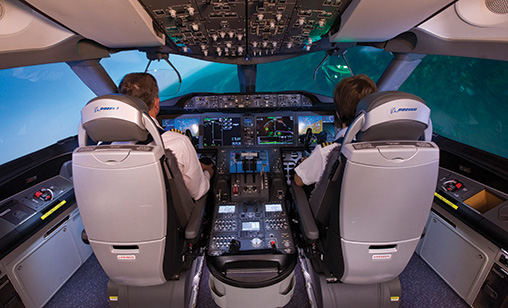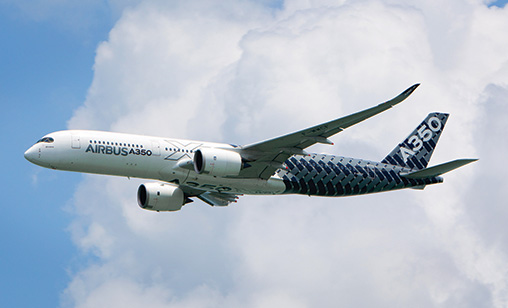Industry Insight Special Report
Challenges of the automated flight deck
As more highly automated aircraft - A380s, B787s, A350s and other new types - take to the sky, the industry is asking if pilots and engineers are being properly trained to fly and maintain them.
November 1st 2016
The International Civil Aviation Organization (ICAO) has identified loss of control of highly automated aircraft as the single most significant threat to aviation safety. Read More » The ruling has sparked widespread industry discussion about aircraft training curriculums for pilots and maintenance engineers as a result of several recent accidents and incidents.
A prime example of the debate was the Air France A330 AF 447 crash in the South Atlantic in June 2009. The aircraft was en route from Brazil to Paris when it disappeared.
 |
When the black box was recovered two years later, it was discovered that the crew reacted incorrectly when the aircraft approached a stall. The pilot pulled back on the sidestick, the reverse of what he should have done.
Five years later, in June 2014, Asiana Airlines flight 214 crashed on landing at San Francisco International Airport in the U.S. The country’s National Transportation Board (NTSB) found the crew mismanaged the approach.
The investigators said the pilots’ over-reliance on automation and their lack of systems understanding were major contributing factors to the crash landing. The NTSB also said the pilot’s faulty mental model of the aircraft’s automation logic led to his inadvertent deactivation of the automatic airspeed control.
In addition, the safety body said the airline’s automation policy emphasized the full use of all automation and did not encourage manual flight during line operations.
Such accidents have been used to advance the view that pilot training curriculums do not train cockpit crew to handle the sophisticated automation of a modern flight deck. The doubts about crew training have been exacerbated by the fact there are no global standards in place for pilot training.
So the questions to be addressed are: is the new breed of airline pilot, surrounded by high technology, losing his or her basic flying skills? And if so, what is being done about it?
At Airbus, pilot training has undergone a radical redesign since its latest aircraft, the A350, was introduced into service. It has been successful so the new curriculum is being extended to pilot training programs for all of the manufacturer’s aircraft types.
At Boeing, its approach to modern flight training also has shifted with the arrival of its Next Gen jet, the B787, with customers from earlier in the decade. In response to the technology built into a Dreamliner cockpit, Boeing has developed an all-digital, Internet-based teaching system for flight and maintenance training on the aircraft.
At a recent Association of Asia-Pacific Airlines air safety seminar, Airbus’ regional senior director south and Southeast Asia, Captain Michel Menestrot, said: “The message we want to pass on is we must think and re-think the training. The work has changed. The technology has changed.
“We have changed. I have some white hair now that I didn’t have 35 years ago when I did my first instructing. We have to use the new technology. But in a way we have to go back to the basics of flying skills and also look at what the basics of training are.”
Menestrot said when Airbus reviewed its training program as the A350 was being developed, new tools were introduced, including the Airbus Cockpit Experience (ACE). ACE is a laptop program featuring the A350 cockpit that allows self-paced study and functional learning for theory and practice.
Students can be taken through every possible procedure step by step, right down to parking the aircraft, either alone or with an instructor’s support. “Everybody is mobile today. Students can take the training to the street. The idea is to make pilot training mobile so we have put the cockpit on a tablet and training can done anywhere,” said Menestrot.
 |
| 'In the simulator, we want to train people in the whole flight envelope, but to stay within the envelope. We want to train people to fly without autopilot, without a flight director, without all the IT. With all that off' |
| Captain Michel Menestrot Airbus regional senior director south and Southeast Asia |
Computer Based Training (CBT), where trainees sit in front of a computer animation of the technical systems, also has been revolutionized with new equipment. The Airbus Pilot Transition trainer (APT) is a more realistic training tool that is making CBT obsolete.
“Look at young people. They never open a manual. They learn by doing. They take the device and start playing with it so now that is part of the A350 training philosophy,’’ said Menestrot.
“What do we want to train?” asks Menestrot. “We want to train some theoretical knowledge. We want to train manual flying skills. We want to train threat and error management. We want to train decision-making and crew communication, together with attitude to achieve this good airmanship. We want to have people we call engaged pilots. We want to avoid complacency. We want pilots to improve their knowledge and their skills.”
At Boeing, it was decided the digital technology of the B787 Dreamliner required a digital training solution. Boeing’s training subsidiary, Alteon, introduced major changes to its training programs to accommodate B787 training requirements.
“The use of personal desktop computers, interactive computer-based training, three dimensional images and desktop simulation make it possible to do much more efficient training,” said Boeing. “Modern flight training devices and simulators combined with these tools and digital delivery offer significantly shorter courses than previous Boeing training programs. The training system and new simulation devices for the B787 use technology that takes learning to the next level.”
For the B787 training program, which mirrors many of the advanced technologies of the aircraft, Boeing built an electronic performance support system rather than a traditional training program.
It is an integrated electronic environment that’s available to trainees at any time.
The effectiveness of this approach also means training is shorter and more efficient. “A B777 pilot can complete B787 flight differences training in five days with no full-flight simulator,” said Boeing. “The maintenance training line and base course is 50% shorter than the B777 course. Distance learning options reduce time at the training center and prepare students for formal training.”
The Seattle manufacturer also has introduced real time simulation in maintenance training. Trainees practice on the same tools in the classroom that the mechanics use in the field on the aircraft.